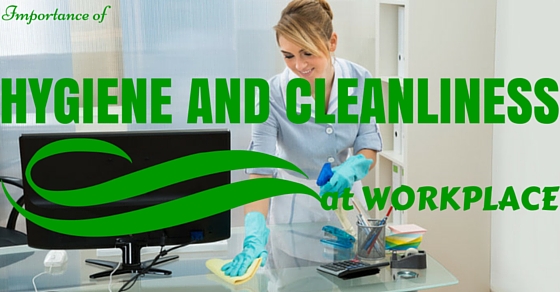‘Cleanliness is next to Godliness‘, is a very famous saying. It instantly connects the word cleanliness into something religious, pure, sacred and divine. But it is not so, in this modern era cleanliness has got several different interpretations to it.
It is not merely a religious deed anymore. With the emergence of more and more inventions and industrialization, there has been a significant rise in germs, diseases, and resultant deaths.
That is why cleanliness and hygiene at the workplace plays a very important role.

Thus, cleanliness and hygiene is given a lot of importance by the people. Prime Minister Narendra Modi, in India, has also started a drive called ‘Swachata Abhiyan‘, which revolves around the idea of cleanliness and hygiene.
People often relate hygiene and cleanliness as one; apparently, cleanliness simply does not define hygiene. Instead, cleanliness is solely a part of it. Let’s look at the difference between both the terms.
People often relate hygiene and cleanliness as one; apparently, cleanliness simply does not define hygiene. Instead, cleanliness is solely a part of it. Let’s look at the difference between both the terms.
Hygiene and Cleanliness:
What is Hygiene?
Hygiene can be said as a set of habits or practices that are executed in order to maintain a good health. Hygiene can be divided into several other types,
- Personal hygiene
- Medical hygiene
- Hand hygiene Home hygiene
- Laundry hygiene
What is Cleanliness?
Cleanliness can be said as a state of being free of dirt and germs. Although it is impossible for one to get rid of the germs entirely regardless of all the techniques, as millions of germs roam about in the air. The aim of cleanliness is simply a healthy environment.
A clean workplace can be said as a place where there is an all-round protection from germs to health. It is not a place which looks clean but a place which actually germs free for the employer, employees and the customers.
Workplaces in the years have realized the importance of a clean and healthy surrounding.
According to a report, the number of death on an everyday basis has declined from 38 to 12 per day. In 2014, around 4,821 workers died in the workplace due to an injury or a disease.
Promoting Employee Cleanliness and Hygiene at the Workplace:
There are several reasons for one to maintain cleanliness and hygiene workplace. As the workplace is the place where several hours are spent by the workers it is important for it to be germ-free and healthy.
Let us have a look in detail about the health and safety procedures in the workplace and why cleanliness is important.
1. Dry and clean slip proof floors:
Slips and falls are one of the very common ways of enduring injuries. Thus, to prevent injuries the floors should be cleaned on a regular basis.
For example, in the lunch area, one of the co-workers spilled the food and the floor is dirtied by it. Immediately cleaning of that area is necessary, as somebody may slip over it and fall down. If the person is lucky enough he doesn’t sustain much injury but at times it may lead to fractures.
Further, after cleaning the floor the wet area can also be a hassle for the people as it is an equal threat. Thus, using an absorbent material at the places where there is a wet floor is advisable. This will definitely lessen the accidents due to slippery floors.
2. Unorganized and messy:
The messy environment is the root of all problems. In the messy environment, there are more chances of threats going unnoticeable and the situation may simply turn the place into an accident-prone area.
Occupational Safety and Hazard Administration (OSHA), defines an occupational hazard as a thing which may cause harm to the employees within the workplace.
An occupational hazard is plainly a result of ignorance on the part of the employer or the carelessness on the part of workers. When the workplace or the office area is messy and unorganized, it may be a door to many uninvited hazardous accidents. So proper office cleanliness or hygiene at work should be practiced.
For example, at the time of emergency caused due to fire breakouts, if the stack of boxes or equipment is placed at the exit, it may cause the employers to fall or trip over them and get injured or stuck in the fire lit building.
There can be various other occasions where the messily left piles can be hazardous in the way of the employees. One can take an instance of a time when one needs a certain material from the piles and stacks of boxes. In that case, there is relatively more risk of the stack falling upon the employees and injuring them.
But it is not just safety that is to be kept in mind when looking out for messy material. An unorganized office may also hamper the productivity rate of the employee. One is unable to retrieve the necessary material at the given time.
Hence again the messy environment can be a total obstacle. Not to forget it is a turn off in the eyes of the customers, as nobody enjoys a dirty scene in front of them. As tidiness speaks the professionalism behind it and thus it is advised to place everything in its place.
3. Use of disinfectants in the workplace:
Disinfectants are very important to be used in public places as there is more risk of germs spreading around due to multiple uses of each and every item.
Similarly, in the workplaces, there is frequent use of items from one employee to another. Whether it is a flu season or not, germs are inevitable in nature. Thus, disinfectants comparatively lessen the chance of any germ produced illness or diseases. But using a clinically approved chemical disinfectant is equally important.
In order to cut the cost some employees may opt for a cheaper disinfectant, which on a longer run can affect the health of the employees. This, in turn, will again lead to health issues and absentees.
Thus, it is advisable to go for EPA registered disinfectants, which are used in hospitals.
4. Germ controls to fight the flu:
Flu season is the season where the attendance register is filled with sick leaves. Employers come across various sick leave applications at this time.
Germs can very easily disperse across the entire workplace if there is any compromise in the cleanliness of the office. Sanitizing the hands as well as workspace is equally important.
For instance, the lunchroom can be called as a germ house for everyone. Specifically, the doorknobs, handles, taps, sink, etc are the places with a lot of germs residing. Thus, it is very important to clean and sanitize these areas very frequently.
Apart from flu there is a higher chance of catching a fatal disease or infection through such shared germs within the workplace. There are several infectious germs that may spread due to the unhygienic environment and lead to various disease.
Some might not even be fatal, for example, a fungal infection. It may not be fatal but it might lead to irritation and skin infections that will decrease their concentration at work.
5. Green and clean is safe and sound:
Eco-friendly products are best in nature and are not at all harmful to human health. They are friendly to nature as well. Not all cleaning products can be compared to one another.
All the products have different standards too. Some are cheaper and harmful whereas some are a bit costlier and trustworthy. It is very important to choose the correct chemical. Along with choosing them it is equally important to store these chemicals in the correct places.
There are more chances of these chemical to cause skin related allergies, which on the longer run can affect the employee’s attention span and confidence.
6. Air filtering and humidity:
Airborne diseases do not stay back in the race of harming and spreading more and more diseases. One may not be able see them, but they can be equal threat in the way of the organization at a whole.
A better ventilation system works as a backbone against the airborne diseases. Germs that can pass through respiratory infections can be tackled by the ventilating system. It will not only enhance the productivity of the workers but also maintain their good health.
Thus, regular cleaning and timely changing of the required filters is very much advisable. This will restrict the potential microbial growth or odor related problems within the work environment. Humidity can also affect the germ level in a building thus maintaining a proper humidity level.
7. Meeting the essential light level:
This one may seem a little irrelevant but it can not be ignored. Dirty light fixtures are indeed one reason to the inefficient light supply. It can be a great hassle in the way of employees. It is proven that adequate light is required in order to do the daily task.
No proper lightening can be an unsafe combination with the workplace. Staircases, aisles and other secluded or equipped areas should be lit efficiently to prevent accidents and contribute to a healthy and safe environment.
8. Perfect waste disposal plan:
Piled up trash can produce dirt all around the places. Piled trash can be the exact place where pesticides can reside and multiply. They can be a great threat and hazard to the work environment.
Placing dust bins or waste bins throughout the places in the company grounds is a way to start. Then there should be guidelines given to the janitorial staff to dispose the waste in the correct place.
Further, reducing and recycling methods should be implemented within the workplace. Lastly, sanitizers should be kept in handy so that there is no hazard of any kind of germs attacking in any manner.
9. Image is everything:
It is not the employees that roam about in the work spaces of your company but also the possible clients, suppliers or may be the investors. The environment of mess, unorganized and dirty workplace can be a total turn off for the possible clients. This can lead to a very first bad impression, and as it is said ‘First impression is the last impression‘.
Further words are known to travel faster than lightning. Along with it there may be a possibility of the potential germs being dispersed to that very client and can create many problems.
10. Prevail assets for a long-lasting period:
Employees and employers are of coursed harmed but apart from that assets like computers, equipment and other materials (Like the coffee machine, lunch room microwave etc) can also sustain damages.
Buildings, carpets, mats etc are the products that are the contribution of the employer to company and thus replacing them every now and then can be too much of a costly affair.
Further, on the part of the employer, it is advisable to invest into commercial cleaning products which may not only preserve the office assets longer but also become a helping hand for the janitorial faculty.
As a result of such a condition, employees productivity is greatly affected. Missed deadlines, incomplete task, unsatisfactory work and so on can be an exact example to describe it.
Further illness and injury could prevail into a long term effect that would undoubtedly be dangerous for not just the employee but also the organization at a whole. Thus, providing a better, clean and safe surrounding to the employees is a duty of the employer.
Office Cleanliness Rules:
The importance of housekeeping at work can be clearly felt when you see the surrounding neat and clean as you enter the workplace. Though every company or organization comprises of housekeeping staff, it is not mandatory that they solely are responsible to maintain office cleanliness.
Employee too needs to understand the importance of cleanliness in the workplace and practice a few workplace hygiene tips so as to maintain a happy and clean office environment. Mentioned below are few workplace cleanliness policy rules that every employee need to follow
Reasons for Cleaning and Hygiene Rules for Office Employees :
- No clutter
- Always use a hand sanitizer
- It is the duty of every employee to help maintain cleanliness in the office
- Make use of rubbish bin policy
- Do not eat at desks
- Usage of alcohol desk wipes
- All the cables must be organized properly
- Have regular meetings to discuss health and safety matters
- Disposal of boxes and packaging covers should be done immediately
By cleanliness, one doesn’t imply ongoing around with brooms and mops for a cleanliness drive.
Cleaning is a process of getting a clean, free, and energetic environment where there is a zero risk of health hazard. Cleaner surrounding makes it easier to organize the workplace and organizing makes it easier to access all sort of material one needs.
Similarly, a clean and organized office environment will not just be beneficial for the staff but also will attract customers. The productivity also increases as it is said ‘dirty place and clean mind cannot work together.
Thus, keep an eye on the work of the janitorial staff, after all your safety and productivity plainly reside on their back.











































